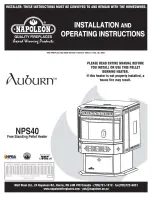
7
800.421.0771
6.
Use only an insulated, all-fuel chimney to vent the hot gases out of the house. It
will reduce the amount of creosote buildup and improve the draft needed to vent
hot gases from the stove.
7.
Use an 8” diameter insulated thimble or an 8” diameter insulated all-fuel chimney
section when passing through a combustible wall or ceiling.
8.
Do not use more than one elbow in the stove pipe.
9.
Any horizontal pipe should be pitched upward toward the chimney at least 1/4
inch for each foot horizontal run.
10.
Be sure there is at least 18” clearance between horizontal piping, if used, and
combustible ceiling.
11.
Ensure that the ventilating pipe does not extend so far into the chimney flu that it
blocks airflow.
12.
Particular attention should be paid to the point where the flu passes through a wall
or a ceiling. This penetration should always be made with insulated pipe and the
proper accessories.
13.
The longer the pipe and the larger the number of elbows, the greater the chances
of dangerous creosote and ash buildup. Modern stoves are engineered to achieve
maximum heat dispersal without lengthy vents eliminating a potentially hazardous
situation.
14.
Use heavy gauge stove pipe; at least 24 gauge, 8” diameter.
15.
Each stove pipe connection should be joined and secured with sheet metal screws
to avoid possible separation during use.
16.
The top must be at least three feet higher than the roof at the point of exit In
pitched roofs, the top of the stove pipe must be at least two feet higher than the
highest point of the roof, and at least ten feet away.
17.
Extend the chimney’s connection pipe at least 12 inches into the chimney.
SAFETY NOTE:
This stove is not approved for use in mobile homes.


































